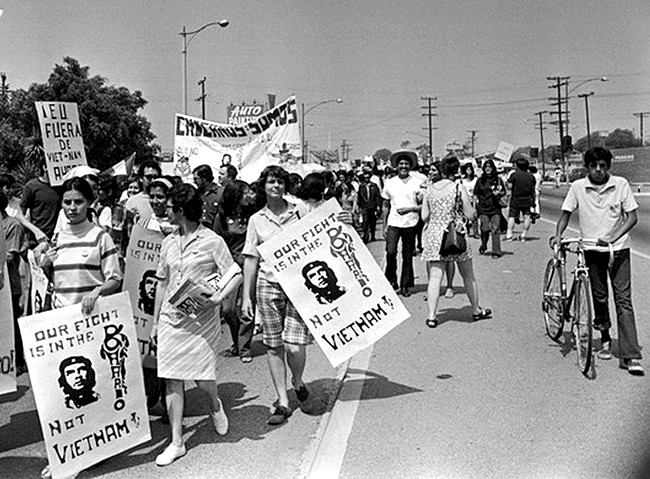Remembering the Chicano Moratorium of 1970
The Chicano Moratorium Committee (NCMC) led a mass movement of Chicanos which protested the racist Vietnam War between 1969 and 1971.
The NCMC built a broad-based coalition of activists and Mexican American groups, which was led by Brown Berets student activists. The Moratorium organized in communities throughout the Southwest holding demonstrations and anti=war activities. The common sentiment of the people was expressed by the popular chant, “Our struggle is not in Vietnam, but in the movement for social justice at home!”

The Chicano Moratorium was a ‘catalytic moment’ for L.A. art 1970.
Resistance to the draft was upheld. Moratorium leader Rosalio Muñoz, in refusing the draft, stated, “Today, the 16th of September, the day of independence for all Mexican peoples, I declare my independence of the Selective Service System.” (La Salle University Digital Commons)
Chicanos were especially protesting the U.S. war in Indochina because they were being killed and wounded at twice the rate of other soldiers. Working=class Chicanos couldn’t get draft deferments because they weren’t in college.
The Los Angeles area was home base to many war industries, like McDonnel-Douglas, Lockheed, Rockwell and Hughes, along with naval shipyards.
Historic march attacked by police
In May of 1970, student protests erupted nationally after demonstrators were murdered by police at Jackson State College (now University) and the National Guard at Kent State University, while protesting the U.S. invasion of Cambodia.
The Chicano Moratorium in Los Angeles had already held two strong protests and a mass march was set for Aug. 29, 1970. There were also Chicano Moratorium marches in at least 10 other cities on this date.
The march of 30,000 Chicanos in East LA traveled down Whittier Boulevard. toward Laguna Park. The march included activists from throughout the Southwest. Families with children, community leaders, teachers and trade unionists also marched. Arriving at Laguna Park, the march was attacked by 1,500 LA police sheriffs without provocation.
March monitors were briefly able to hold the cops back, but the cops broke through the line. They bombarded the peaceful protesters with tear gas, beat them with billy clubs and carried out extreme acts of cruelty. Large numbers were wounded and arrested. The ending rally was broken up.
Three activists were murdered by the cops that day: Angel Gilberto Diaz, a Brown Beret; Lyn Ward, a Brown Beret medic; and Ruben Salazar, a well-known Chicano journalist who was considered the voice of the community.
This is the same treatment doled out to Palestinians and pro-Palestine demonstrators in this country today.
The response to this cop repression was a mass rebellion up and down Whittier Boulevard, as merchandise was liberated from pawn shops and other stores that cheated the Chicano and Latine communities. Some stores went up in smoke.
But the Moratorium showed it wasn’t defeated and in 1971 organized a mass statewide march to the capital, Sacramento, to protest the racist and anti-worker policies of Gov. Ronald Reagan.
The death of Ruben Salazar was exposed as a blatant police murder as it was shown that he was shot with a police tear gas canister through the window of the Silver Dollar Cafe. Today Laguna Park is named Ruben Salazar Park.
The inspiration and legacy of the Chicano Moratorium will continue since it is commemorated every year in Los Angeles and other communities in the Southwest.

